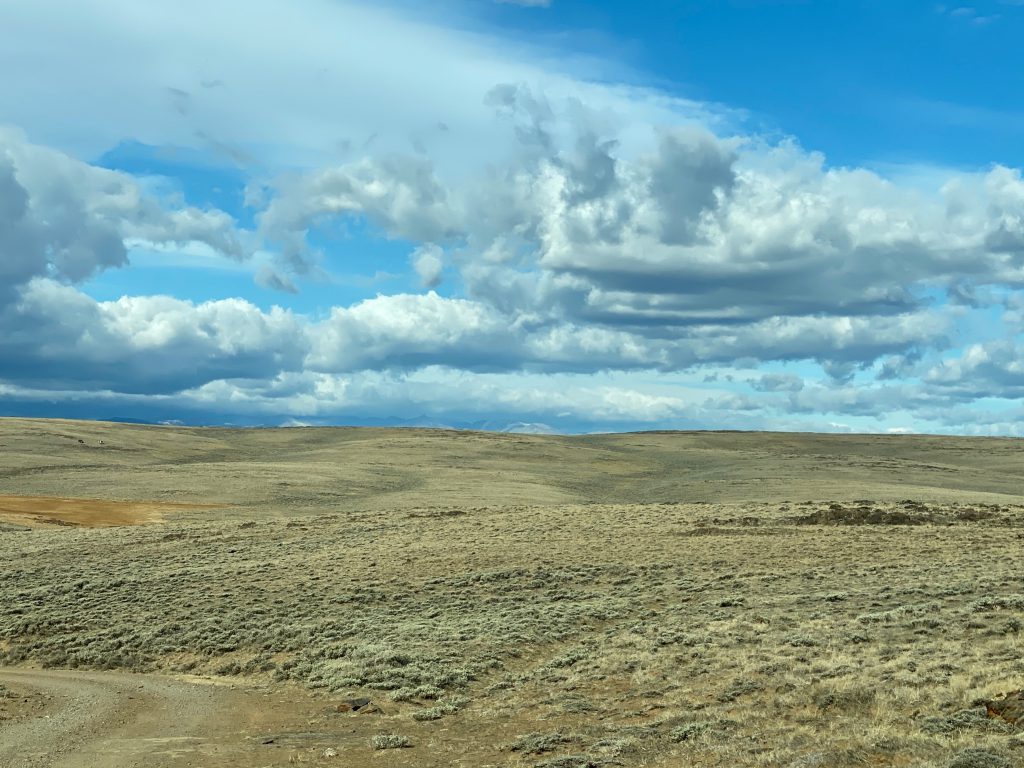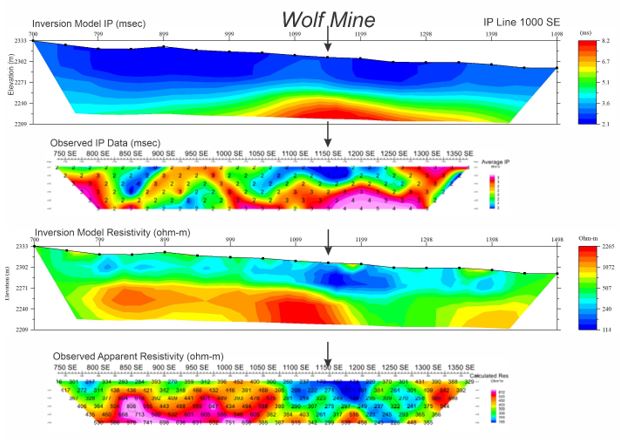Visionary Gold Corp Announces Initial Wolf Gold Project Field Results

Visionary Gold Corp (“Visionary” or the “Company“) (TSXV: VIZ) is pleased to provide initial results from its 2020 exploration program at the Wolf Gold Project in Fremont County, Wyoming. In 2020 Visionary assembled, through leasing and staking, a 10.25km2 land position within the historic Lewiston Gold District, a historically productive gold-rich area within the South Pass Greenstone Belt of Wyoming. The initial focus has been on characterising the known high-grade mineralisation at the historic Wolf Mine and identifying drill targets along the Wolf Shear Zone; a chlorite – hematite altered shear zone that has been mapped at surface for over 1,000m with a known surface expression up to 50m wide.
Highlights include:
• Rock chip samples of a fault gouge within the Wolf Shear Zone returning 19.87 grams per tonne gold (g/t) and 20.63 g/t gold.
• Rock chip channel samples across a portion of the alteration envelope within the Wolf Shear Zone returning 8.0m of 2.13 g/t gold including 2.0m of 5.67 g/t gold.
• Additional Rock Chip and Surface samples ranging from 2.63 g/t gold up to 15.46 g/t gold in the alteration envelope within the Wolf Shear Zone.
• Induced polarisation (IP) test survey indicates coincident IP response and resistivity response may be the signature for mineralisation along the Wolf Shear Zone.
Visionary CEO Wes Adams comments, “We are very encouraged by these results that have highlighted a clear initial target for drilling, as the Wolf Shear Zone is showing high-grade potential at surface, which coincides with a geophysical anomaly at depth. The next objective is to develop a better understanding of the grade and continuity of mineralisation along strike and to further examine the relationship between gold mineralisation and the underlying geophysical anomaly. We look forward to seeing additional results from phase two rock sampling, initial geochemical soil sampling and additional geophysical surveying on the Wolf Claim Group as we work toward phase one drilling in 2021, the first ever at Wolf.”
Rock-chip sampling summary
Historical shafts, tunnels and prospect pits along strike surrounding the historic Wolf Mine appear to have targeted high-grade gold mineralisation within the visibly altered greywacke host rock, from surface to depths of 15m. Initial sampling targeted exposed outcrop and dumps near the shafts, tunnels and prospect pits to determine potential grades of gold mineralisation occurring in the historically mined area. A channel sample collected across the interpreted strike of the altered Wolf Shear returned 8.0m of 2.13 g/t gold including 2.0m of 5.67 g/t gold. This sample stopped just short of historical shafts sunk on an approximately 2m fault gouge due to inaccessibility, however samples along the fault gouge returned values of 19.87 g/t and 20.63 g/t gold approximately 10m southeast of the aforementioned channel sample (figure 1). In total 76 rock chip samples taken regionally have been assayed and analyzed for gold and pathfinder elements using 35-Element ICP analysis. Of the 76 samples reporting results from across the Wolf Claim Group, 47 had anomalous values over 0.2 g/t gold and 22 had values over 1g/t gold. Complete sample tables will be posted to the company’s website (VisionaryGoldCorp.com) once all data has been received, reviewed and interpreted.
Summary of 2020 Exploration Program
In addition to rock chip sampling, Visionary has conducted regional geochemical soil sampling on the Wolf and Miz prospects, evaluated the use of ground magnetic surveys on a portion of the Wolf prospect and evaluated induced polarization geophysical surveying on the Wolf and Miz prospects. A summary of work conducted in 2020 is shown in the table below.
Summary of work completed
Initial Geophysical Analysis
Geophysical surveys were contracted from Collier Consulting of Lakewood, CO; additional data processing was contracted from Kenco Minerals of Littleton, CO. Geophysical data review is on-going with that on the Wolf Mine presented within.
IP geophysical surveying was used to determine if the Wolf Mine had a geophysical signature for this survey method. Given the alteration, veining and inferred sulphide content it was expected that a coincident relatively moderate resistivity measurement along with a relatively moderate to strong IP response would represent a potential target in the shear zone. Results from the evaluation survey, using both the 25m spaced and 50m spaced dipoles, show an apparent resistivity break and chargeability high indicating a potential zone of silicification and weak sulphide mineralisation at depth below the oxidized area of known high-grade gold mineralisation at the Wolf Mine, shown in figure 2. The coincident responses as hypothesised should provide quality targets in the sheared and altered greywackes (figure 2) both in the Wolf Shear Zone and other similar structures in the district.
Next Steps
Drilling in 2021 will test the IP target below the historic Wolf Mine to characterise the alteration, determine the extent of oxide gold mineralisation and the possible extension of mineralisation into the underlying sulphides. Drilling will also help Visionary gain a better understanding of the structural controls of mineralisation, which will be important as exploration efforts expand regionally. Additional IP geophysical surveying along the known Wolf Shear Zone and  broadening the soil survey to cover the entire Wolf claim group is also a top priority.
Visionary Gold Corp, (TSX-V: VIZ) is a precious metals focused, mineral exploration company based in Vancouver, Canada, with Operations in Wyoming, USA. The company is currently focused on the Wolf Gold Project, in Fremont County Wyoming, USA. For additional information, please visit the Company’s website at: http://www.visionarygoldcorp.com/
Contact:
Wes Adams, Chief Executive Officer
Visionary Gold Corp.
410-325 Howe Street
Vancouver, BC V6C 1Z7
Tel: (303) 809-4668
Figure 1: Sample locations along and adjacent to the historical Wolf Mine and shear zone.
Figure 2: Test IP line across the historic Wolf Mine and shear structure.
Disclosure Regarding Forward-Looking Statements
This news release contains “forward-looking statements” within the meaning of Canadian securities legislation. These include, without limitation, statements with respect to the advancement of the Wolf Gold Project. Forward-looking statements are necessarily based on a number of estimates and assumptions that, while considered reasonable, are subject to known and unknown risks, uncertainties and other factors which may cause actual results and future events to differ materially from those expressed or implied by such forward-looking statements. Such factors include, but are not limited to capital and operating costs varying significantly from management estimates; the preliminary nature of metallurgical test results; delays in obtaining or failures to obtain required governmental, environmental or other project approvals; uncertainties relating to the availability and costs of financing needed in the future; inflation; fluctuations in commodity prices; delays in the development of projects; and the other risks involved in the mineral exploration and development industry generally. Although the Company believes that the assumptions and actors used in preparing the forward-looking statements are reasonable, undue reliance should not be placed on these statements, which only apply as of the date of this news release, and no assurance can be given that such events will occur in the disclosed time frames or at all. Except where required by law, Galileo disclaims any intention or obligation to update or revise any forward-looking statement, whether as a result of new information, future events, or otherwise.
Technical Disclosure
To date, 130 rock chip, dump and grab samples were taken on the Company’s claims with 76 samples reported herein; gold values ranged from detection limit to 20.63 g/t with a median value of 0.402 g/t. Dump, grab and rock samples are selective in nature whereas the chip channel and rock chip samples were collected on a defined width as semi-representative material across geological features. Channel and chip samples were collected at one metre intervals or at 0.3 metre intervals. No certified reference material was used in the sample stream during this initial field program and the Company has relied on the respective Laboratory’s re-analysis procedure and the use of laboratory standards, Field programs subsequent to this 2020 program will have in place an internal QA/QC procedure and sampling protocols that match industry best practices. Laboratories used for the analyses of the samples included Paragon Geochemical Ltd (ISO/IEC 17025:2017) of Sparks, NV using codes Au-OES30 and Au_GRAV30 for over-limits and 35AR-OES for multi-element analysis (main field program, approximately 30% of the samples; contracted laboratory for 2020 field program); American Analytical Services (ISO/IEC 17025:2005) of Osborn, ID using code FA-Ag/Au (reconnaissance samples, approximately 40% of the submitted samples), and Skyline Assayers and Laboratories (ISO/IEC 17025:2017; ISO 9001:2015) of Tucson, AZ using codes FA-01-50g and TE-2 for multi-element analysis (property due diligence samples, approximately 30% of the submitted samples).
The ground magnetic survey was undertaken on a prescribed grid with line spacing 100m apart collecting continuous data along the lines using a Geometrics G-859 magnetometer rover system with a G-857 base station. Induced polarisation data was collected initially with a 25m spaced dipole-dipole and then with a 50m spaced dipole-dipole setup.
All scientific and technical information contained within this press release was prepared under the supervision of Darren Lindsay, P.Geo. (EGBC), a Qualified Person as defined by NI 43-101. Mr. Lindsay is a Director of the Company.
It should be noted that the potential quantity and grade of the exploration targets disclosed in this press release is conceptual in nature, that there has been insufficient exploration to define a mineral resource and that it is uncertain if further exploration will result in the target being delineated as a mineral resource as per the NI 43-101 reporting standards.
Neither the TSX Venture Exchange nor its Regulation Services Provider (as that term is defined in the policies of the TSX Venture Exchange) accepts responsibility for the adequacy or accuracy of this release.



